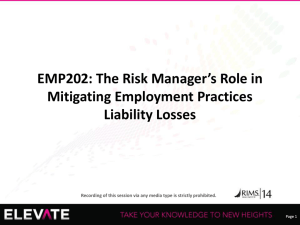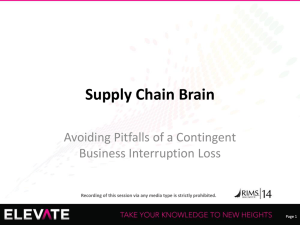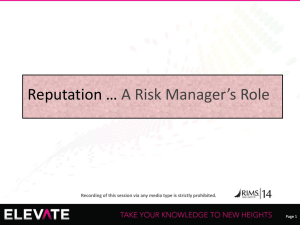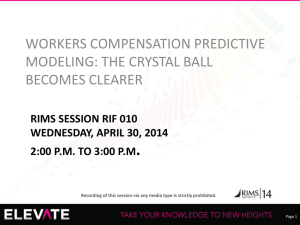Flood Insurance
advertisement
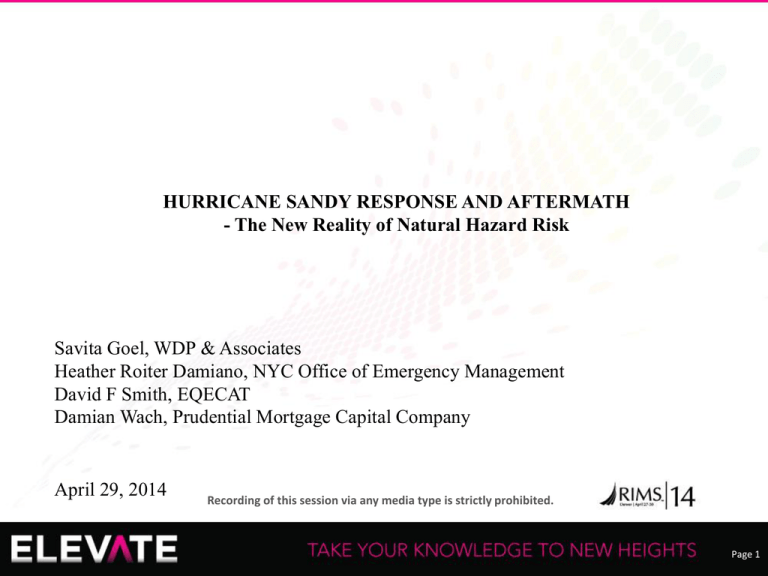
HURRICANE SANDY RESPONSE AND AFTERMATH - The New Reality of Natural Hazard Risk Savita Goel, WDP & Associates Heather Roiter Damiano, NYC Office of Emergency Management David F Smith, EQECAT Damian Wach, Prudential Mortgage Capital Company April 29, 2014 Recording of this session via any media type is strictly prohibited. Page 1 LEARNING OBJECTIVES • Assess how natural hazards and their threat to your organization have changed. • Lessons learned from the vantage point of key players in postevent response • Incorporate your peers’ life-lesson adjustments into your own natural disaster response program April 29, 2014 Recording of this session via any media type is strictly prohibited. Page 2 OUTLINE • • • • • • • • • April 29, 2014 Introduction to Speakers Hurricane Sandy and CAT Modelling Overview of NYC Infrastructure Key Characteristics and Vulnerabilities Aftermath of Hurricane Sandy Challenges with Planning Post-Sandy Risk Manager’s outlook Discussion on Lessons Learned Q&A Recording of this session via any media type is strictly prohibited. Page 3 INTRODUCTIONS Introduction to Speakers - Savita Goel, WDP - David Smith, EQECAT - Heather Roiter, NYC OEM - Damian Wach, Prudential Recording of this session via any media type is strictly prohibited. Page 4 Superstorm Sandy - Highlights • Cat 1 (80 mph 1-minute) at Atlantic City, NJ landfall • Very broad windfield ~1000 mile diameter of tropical storm force winds o Rmax significantly larger than 1938 storm o ~$ 20 trillion in insurable assets in affected states o • Very low pressure (948 mb recorded at Atlantic City) • Surge heights: ~14 feet in lower Manhattan: extreme o ~9 feet at Atlantic City: not as exceptional but still very damaging in portions of the NJ coast o • Rainfall amounts and rates ~ lower than Irene o Much less inland flooding Recording of this session via any media type is strictly prohibited. Page 5 Superstorm Sandy Superstorm Sandy Track Historic Tracks 1903 was only event that directly struck NJ coast (Cat 1, transitioning) Recording of this session via any media type is strictly prohibited. Page 6 Modeled landfall frequencies (long term): • Virginia – Maine ~ 1 / 8 years • New York ~ 1 / 20 years • New Jersey ~ 1 / 180 years Recording of this session via any media type is strictly prohibited. Page 7 Storm Name Intensity (mph) Rmax (km) Forward Speed (km/hr) 1938 98 95 65 Irene (NJ) 65 74 29 Sandy 80 110 37 Boston New York Philadelphia Baltimore Atlantic City Washington Recording of this session via any media type is strictly prohibited. Page 8 Reported •Atlantic City, NJ - 77 mph •Cape May, NJ - 73 mph •Clifton, NJ - 80 mph •Coney Island, NY - 69 •Dennisville (Near Cape May) - 81 mph •Greenwich, CT - 70 mph •Islip Airport , NY- 90 mph •JFK Airport , NY– 79 mph •Montclair, NJ - 88 mph •New Haven, CT - 85 mph •Newark Airport, NJ - 78 mph •Ocean City, NJ - 60 mph •Sandy Hook, NJ - 87 mph (it is a buoy) •Sandy Hook, NJ (onshore) - 81 mph •Surf City (Ocean County), NJ - 89 mph •Tompkinsville, NY – 90 mph •White Plains Airport, NY – 72 mph Boston New York 70 85 8072 90 78 90 72 Philadelphia 87 Baltimore Washington 60 73 89 77 Recording of this session via any media type is strictly prohibited. Page 9 Surge - Enhancing Factors Factors enhancing Sandy’s Surge at Landfall • Higher Winds • Lower Pressure • Faster Translation Speed • Perpendicular Landfall • Wider Storm - More Area Affected • Shallow Offshore Slope • Confining Coastline Geometry • Peak Surge occurring at High Tide • Higher Astronomical Tide (Full/New Moon) Recording of this session via any media type is strictly prohibited. Page 10 Surge – Coastline Geometry NY Bight: The “corner” where NJ and NY meet at approximately 90º. Water can be funneled into the corner and pile up with nowhere to go but up. Sandy’s track allowed for a long duration of winds directing water into Raritan Bay and NY Harbor. L Recording of this session via any media type is strictly prohibited. Page 11 Battery Park NYC – Storm Tide Resulting Storm Tide Storm Surge Normal Tide Recording of this session via any media type is strictly prohibited. Page 12 Superstorm Sandy – Loss Estimates Losses By State Others 16% PA 20% NJ 30% NY 34% Losses By Line of Business Commercial 40% Residential 60% • The estimated economic loss for this event is about $30 to $50 Billion • Based on the event footprint and EQECAT IED, the post-landfall (Nov. 1, 2012) insured loss estimate for Sandy is approximately $10 to $20 Billion (Later revised to $15-$20 Billion) • Latest PCS: $18.75 Billion • ~1-in-10 for U.S. • ~1-in-70 for Northeast (VA-ME) Recording of this session via any media type is strictly prohibited. Page 13 Residential flood insurance take up rates in New York in 2010 with Sandy storm surge estimates Source: Resources for the Future, with data from FEMA Recording of this session via any media type is strictly prohibited. Page 14 Residential flood insurance take up rates in New Jersey in 2010 with Sandy storm surge estimates Source: Resources for the Future, with data from FEMA Recording of this session via any media type is strictly prohibited. Page 15 Flood Damage • The National Flood Insurance Program (NFIP) reports that for a 1-story building, the average cost to replace by flooding height is: 1 foot - 22% 2 feet - 32% 6 feet - 58% 8 feet - 68% • NFIP reports that 25 to 30 percent of all paid losses were for damage in areas not officially designated at the time of loss as special flood hazard areas. (NFIP coverage is available outside high-risk zones at a lower premium.) Recording of this session via any media type is strictly prohibited. Page 16 Hurricane / Named Storm Deductibles (1) • Special hurricane deductibles had been introduced in 10 of the states affected by this event (DE, MA, MD, ME, NC, NY, RI, SC, VA), increasing the portion of hurricane damage that is the responsibility of policy holders. • Hurricane deductibles are separate thresholds that damage must exceed before insurers will indemnify losses. Hurricane deductibles of from 1% to 5% of the structure replacement value are not uncommon. Some hurricane deductibles have Cat 2 or 3 thresholds. • Insurance Commissioners and Governors were quick to instruct companies not to apply these deductibles. Recording of this session via any media type is strictly prohibited. Page 17 Hurricane / Named Storm Deductibles (2) • Sandy was downgraded to a post-tropical storm system just before it made landfall in New Jersey. • Sandy was not treated as a Hurricane for Insurance Purposes. The Regulators did not overrule the Hurricane Deductible elements in the contracts but rather chose to enforce the Meteorological Assessment that Sandy had ceased to be a Hurricane before landfall. Recording of this session via any media type is strictly prohibited. Page 18 Wind vs. Flood - Policy Structures Quantifying the risk for policies with distinct insurance conditions for different sub-perils (e.g. wind limit and flood sublimit) requires: • financial modeling that explicitly addresses such conditions • exposure data representation that explicitly addresses such conditions Recording of this session via any media type is strictly prohibited. Page 19 NYC INFRASTRUCTURE OVERVIEW Key Features of Infrastructure - Coastal development - Development in 100-yr flood plain - Utilities infrastructure is underground – Power, Water, Wastewater - Transportation - Underground subways and the supporting infrastructure Recording of this session via any media type is strictly prohibited. Page 20 INFRASTRUCTURE OVERVIEW – Coastal Development Lower Manhattan in 1940’s Lower Manhattan Now In 1940 Population – 7.5 million Buildings – Lot less than a million In 2013 (within 100-year Flood Plain) Population – ~5% of 8.2 million Buildings – ~7% of a million Recording of this session via any media type is strictly prohibited. Page 21 INFRASTRUCTURE Utilities – An Underground City - Power lines: 70% of 130,000 miles of transmission & distribution underground - Steam: 105 miles underground pipelines - Gas: 65% of heating and fuels 98% of electricity production - Water: 7000 miles of buried water mains and pipes Recording of this session via any media type is strictly prohibited. Page 22 INFRASTRUCTURE - Transformers vaults with access from sidewalk - Grating Covers Recording of this session via any media type is strictly prohibited. Page 23 INFRASTRUCTURE Transportation - Roadway: 6000 miles - Inter-borough connection: Bridges & Tunnels Recording of this session via any media type is strictly prohibited. Page 24 INFRASTRUCTURE Transportation - Subways: Approx 5.3 million daily rides and approx. 850,000 daily commuter rides into and within NYC Recording of this session via any media type is strictly prohibited. Page 25 BUILDINGS INFRASTRUCTURE Key Features - Buildings with basement (sometimes multiple levels below grade) - PoE of utilities located below grade - Server rooms/ control room located in basement - Sidewalk vault with grating for ventilation - Emergency power: - Fuel tanks located in basement - Emergency Generators higher up Recording of this session via any media type is strictly prohibited. Page 26 CONSTRUCTION TYPES - Brownstone - High-rise Recording of this session via any media type is strictly prohibited. Page 27 KEY ATTRIBUTES Older Buildings - Smaller windows - Heavy Exterior Walls Masonry or stone veneer - More redundancies in design - Ballast roof - Rooftop equipment unanchored - Water tank Recording of this session via any media type is strictly prohibited. Page 28 KEY VULNERABILITIES Older Buildings - Ballast roof - Rooftop equipment Recording of this session via any media type is strictly prohibited. Page 29 KEY VULNERABILITIES Older Buildings - Rooftop equipment unanchored - Water tank Recording of this session via any media type is strictly prohibited. Page 30 KEY ATTRIBUTES/ VULNERABILITIES Newer Buildings - Structural System – less redundancies - Large Size Windows - Vulnerable Façade System Recording of this session via any media type is strictly prohibited. Page 31 DAMAGE FROM HURRICANE SANDY Flooding Recording of this session via any media type is strictly prohibited. Page 32 DAMAGE FROM HURRICANE SANDY Lower Manhattan in Dark in Aftermath of Hurricane Sandy Recording of this session via any media type is strictly prohibited. Page 33 DAMAGE FROM HURRICANE SANDY Subway Tunnel Flooded Recording of this session via any media type is strictly prohibited. Page 34 DAMAGE FROM HURRICANE SANDY Buildings – High Rise - Flooding - Minimal to no structural damage - Disruption led cash flow losses Recording of this session via any media type is strictly prohibited. Page 35 DAMAGE FROM HURRICANE SANDY Buildings – Single Family Homes - Flooding - Structural damage and/or fallen tree Recording of this session via any media type is strictly prohibited. Page 36 Upcoming Code Upgrades Following Lessons Learned Flood Maps - New FIRMs - Buildings in 100-yr flood zone are mandated to have flood protection plan in place Building Codes - Upgraded NYC Building Code in Oct. 2014 Recording of this session via any media type is strictly prohibited. Page 37 Challenges with Planning Post-Sandy Heather Roiter Damiano Director of Hazard Mitigation NYC Office of Emergency Management Recording of this session via any media type is strictly prohibited. Page 38 NYC Coastal Storm Plan “Largest and most operational CSP in the country.” Recording of this session via any media type is strictly prohibited. Page 39 The Story of Sandy Recording of this session via any media type is strictly prohibited. Page 40 CONFIDENTIAL Different Parts of the City Faced Different Types of Flood Hazard DOB Tagging by Flood Type and Geography Surge and Wave Action Atlantic Coast shorelines faced inundation plus impact wave action Surge and Wave Action Stillwater Flooding Structures are primarily low-rise residential Severe structural damage concentrated in areas directly facing shoreline Upper Harbor Stillwater Flooding Upper Harbor and other areas to the north generally experienced inundation only Damage primarily to mechanical, electrical, and telecommunication systems and building contents Atlantic Coast Recording of this session via any media type is strictly prohibited. Page 41 CONFIDENTIAL PlaNYC: A Stronger, More Resilient New York Mayor Bloomberg released 6/11 Offers a roadmap to protect the city against climate hazards and sea level rise Sets City’s priorities and strategies for longterm resiliency Community Recovery • Lower Manhattan ; Brooklyn/Queens Waterfront; Southern Brooklyn; South Queens; Mid/South Staten Island Infrastructure and Built Environment 250 specific recommendations Coastal protection Buildings Insurance Utilities Liquid Fuels Community Preparedness Healthcare Facilities Telecom Transportation Parks Wastewater and water nyc.gov/resiliency Recording of this session via any media type is strictly prohibited. Page 42 CONFIDENTIAL OEM’s Hurricane Evacuation Map Based on the SLOSH* model A worst-case scenario model that is used for evacuation purposes A combination of hurricane modeling and evacuation route analysis to produce Zones 1 through 6. Recently updated (August 2013) to provide more flexibility in evacuation options and reduce confusion with FEMA FIRMs *SLOSH stands for Sea, Lake, and Overland Surges from Hurricanes Recording of this session via any media type is strictly prohibited. Page 43 FEMA’s Flood Insurance Rate Maps (FIRMs) FEMA’s flood maps are developed as part of the National Flood Insurance Program. Key functions: Basis for understanding current flood risk (coastal and riverine) Inform building code standards Determine flood insurance requirements NYC’s first FIRMs were issued in 1983 FEMA currently updating NYC’s maps Recording of this session via any media type is strictly prohibited. Page 44 Flood Insurance Rate Maps FEMA’s FIRMs designate flood zones based on different types of hazards. The Base Flood Elevation (BFE) is the height to which the flood waters are expected to rise. Recording of this session via any media type is strictly prohibited. Page 45 National Flood Insurance Program Reform The NFIP has undergone significant regulatory change over the last 18 months. July 2012: Biggert-Waters Flood Insurance Reform Act NFIP Challenges • Pre-Sandy, NFIP was $18B in debt to Treasury ($16B from Katrina) • Expected Sandy payouts are $12-15B • Subsidized rates do not adequately reflect actual flood risk March 2014: Homeowner Flood Insurance Affordability Act • Prohibit premium subsidies on new or lapsed policies • Repeals trigger for new or lapsed policies • Phase out subsidies for all policies • Caps rate increases at 18% annually (some exceptions) • Require banks to enforce purchase requirements more vigorously • Enables newly mapped properties to purchase preferred risk rate for 1 year • Analyze affordability impacts by April 2013 • Authorizes additional funds for affordability study • Provides refunds for certain policies affected by BW-12 Recording of this session via any media type is strictly prohibited. Page 46 Flood Insurance Rate Maps Sandy demonstrated that New York was more vulnerable than previously thought. FEMA 1983 FIRMs vs. Sandy Inundation Area Damage outside 1983 100-year floodplain: • > 1/3 of red- and yellowtagged buildings • ~ 1/2 of impacted residential units • > 1/2 of impacted buildings Source: FEMA (MOTF 11/6 Hindcast surge extent) FEMA 1983 FIRMs 100-year Floodplain Sandy Inundation Area (outside the 100-year Floodplain) Recording of this session via any media type is strictly prohibited. Page 47 CONFIDENTIAL Flood Insurance Rate Maps The most recent maps, called Preliminary FIRMs, were released in December 2013 and show a floodplain that is 51% larger than previously. FEMA 1983 FIRMs vs. Preliminary FIRMs 100-year Floodplain* 1983 FIRMs 2013 PFIRMs Change (%) Residents 218,000 398,000 82% Jobs 214,000 271,000 27% Buildings 36,000 68,000 89% 1-4 Family 26,000 53,000 104% Floor Area (Sq Ft.) 377M 534M 42% * Numbers are rounded for clarity Source: FEMA FEMA 1983 FIRMs 100-year Floodplain FEMA 2013 Preliminary FIRMs 100-year Floodplain Recording of this session via any media type is strictly prohibited. Page 48 CONFIDENTIAL Flood Insurance Rate Maps Given the City’s projections on sea level rise, these floodplains will extend even further by the 2020s and into the 2050s. Projected floodplain for the 2020s and 2050s 100-year Floodplain* 2013 PFIRMs 2050s Projected Change (%) Residents 398,000 801,000 82% Jobs 271,000 430,000 27% Buildings 68,000 114,000 89% 1-4 Family 53,000 84,000 104% 534M * Numbers (Sq Ft.)are rounded for clarity 855M 42% Floor Area Source: FEMA Source: FEMA; CUNY Institute for Sustainable Cities FEMA 2013 Preliminary FIRMs 100-year Floodplain Projected 2020s 100-year Floodplain Projected 2050s 100-year Floodplain Recording of this session via any media type is strictly prohibited. Page 49 CONFIDENTIAL Affordability Challenges The analysis shows that pre- and post-FIRM annual premium increases will be significant due to the implementation of BW-12 and the FIRM update… Annual Premiums Scenario Attached 1-2 Family Red Hook, Brooklyn Detached 1-2 Family Gerritsen Beach, Brooklyn Detached 1-2 Family Midland Beach, Staten Island Multistory Current New NA $4,100 $429 $8,045 $506 $2,365 Uninsured Pre-FIRM in 100-year floodplain • Lowest floor relative to BFE: -5 • Has a basement Newly mapped Pre-FIRM in 100-year floodplain • Lowest floor relative to BFE (new): -9 • Has a basement Existing Post-FIRM in 100-year floodplain • Increase in BFE: 4 • Lowest floor relative to BFE (new): -1 Existing Pre-FIRM multistory • Lowest floor relative to BFE (new): -9 • Has a basement unknown Recording of this session via any media type is strictly prohibited. Page 50 CONFIDENTIAL City Efforts and Next Steps: Flood Insurance City is taking steps to reduce risk and increase understanding of its exposure. 1 Reduce risk • City’s $19.5 Billion plan lays out 257 initiatives to strengthen coastal defenses, improve buildings, protect infrastructure and make neighborhoods safer and more vibrant 2 Improve risk-based pricing: • Neighborhood: Army Corps and FEMA do not always agree on flood protection benefits • Household: 40% of City’s buildings cannot be elevated; exploring alternative mitigation strategies • “Pre-FIRM” construction: Need updated rate-setting methodology for old building stock (focus of the Negatively-Rated Building Study being conducted by the National Academy) 3 Explore data collection options and launch affordability study • Working with FEMA and Google on low-cost approaches to gathering elevation data • Launching a 10-month study to assess affordability impacts and potential solutions 4 Inform the public: • Launching public education campaign regarding risks, mitigation and flood coverage Recording of this session via any media type is strictly prohibited. Page 51 City Efforts and Next Steps: Codes and Standards The City Council introduced over 20 bills to address resiliency in 2013 Flood-resistant construction for hospitals and nursing homes Communicating risk and emergency plans Fuel storage in flood zone Building Resiliency Task Force: 33 proposals Proposed changes to codes Best practices/guidelines for emergency planning and response A Stronger, More Resilient New York recommends retroactive requirements for existing large buildings and for hospitals Enhance protection of mechanical equipment Avoid long-term operational losses in a future flood event Recording of this session via any media type is strictly prohibited. Page 52 CONFIDENTIAL Property Risk Management with Insurance Property value may decrease due to unforeseen financial or physical loss (ie flooding). Property Value Owner JV Partners Mezzanine Lender Junior Lenders Catastrophic damage is of particular concern to risk managers due to severity of loss – may restructure ownership. Property insurance is the primary risk mitigate against catastrophic loss of value. Senior Lenders Conceptual Real Estate Investment Structure Recording of this session via any media type is strictly prohibited. Page 53 Property Risk Management with Insurance What type and how much property insurance is needed? Basic Property Coverage • Need for catastrophic coverage (flood, windstorm, earthquake) determined by location and property characteristics. • National Flood Insurance Program (NFIP) requires flood coverage through mortgage process. • Need for flood coverage usually determined by current Flood Insurance Rate Maps (FIRMS). • Windstorm coverage usually included in property policy. • Need for earthquake insurance usually determined by Seismic Zone or USGS’s PGA charts. Recording of this session via any media type is strictly prohibited. Page 54 Property Risk Management with Insurance 100% • Windstorm insurance limits usually equal insurable value (IV); no analysis needed. However, hurricane classification may impact coverage. • Earthquake limits usually much less than IV; determined by seismic risk or probable maximum loss (PML) analysis. • Flood limits usually equal NFIP limits. Property Replacement Value 90% 80% 70% 60% 50% 40% 30% 20% 10% • residential -$250k plus $100k for contents • commercial - $500k plus $500k for contents. 0% Property Insurance Limit Windstorm Sublimit Earthquake Flood Sublimit Sublimit Type of Coverage • Flood coverage rarely determined by probable maximum loss (PML) analysis. Recording of this session via any media type is strictly prohibited. Page 55 Property Risk Management with Insurance Flood & Windstorm Risk Management in East Coast • Many properties in US high risk flood areas (Special Flood Hazard Areas – SFHAs) rely exclusively on NFIP flood insurance. • In many cases, the NFIP limits of $250k for residential and $500k for commercial may be insufficient to cover probable maximum loss. • In NYC, property characteristics such as location of mechanical equipment, electrical transformer, back-up power generators, etc. historically not considered in determining flood limits. • Current Flood Insurance Rate Maps (FIRMS) or pending maps should be relied upon to determine flood risk. • Property management’s ability to manage flood or windstorm restoration also critical in minimizing loss (ie - shortage of restoration contractors, generators, materials after Sandy). • Best practice: engage a team and develop a detailed risk management plan before the crisis. Recording of this session via any media type is strictly prohibited. Page 56

